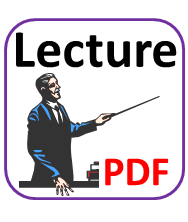Feedback Control, Fall 20
(フィードバック制御 SCE.C.202)
Instructor
 |
Department of Systems and Control Engineering, Tokyo Tech Office: S5-303B |
Lecture Time and Place
Monday and Thursday 5-7 periods (13:20-15:50), S224 Lecture Room
Credit
Unit: 2-1-0
Teaching Assistants
Hayato Dan, Tomoki Adachi, and Yuuki Taya(S5-303A)
Email :
Please send e-mail to the above address if you have any questions. Note that Prof. Fujita's address is not included in the above address.
Office Hour
- Monday and Thursday 15:50-16:35, S5-303A Student Room
Course Description
The purpose of this course is to provide the students with the principles and tools of feedback control: sensitivity, steady-state error, vector locus, Bode plots, internal stability, Nyquist criterion, stability margin, robustness, loop shaping, PID control, two degree-of-freedom control. The students will be introduced to the computational tools for dynamical systems available in Control System Toolbox. (More)
Course Learning Outcomes
1. An ability to formulate, analyze and design fundamental control problems
- Advantages of feedback control
- Characteristic of feedback systems: sensitivity and steady-state behavior
- Frequency response of systems: vector trajectory and bode diagram
- Internal stability of feedback systems: Nyquist's stability criterion and stability margin
- Model uncertainty and robustness analysis of feedback systems
- Design of feedback systems: Loop Shaping, PID compensation, Phase-Lead-Lag compensation
- Two-degrees of freedom control systems
2. An ability to use a numerical computing environment, such as MATLAB and Simulink, to solve engineering problems
Grading
1. Exercises and also your interaction with the TAs and instructor : 20%
2. Midterm exam : 40%
3. Final exam : 40%
- Exams will be closed book and closed notes. The students may prepare a A4 size cheat sheet in your own handwriting, consisting of two-sided sheet for midterm and final exams.
Textbook
The primary text for the course and the excercise is :
| [1] | 杉江俊治,藤田政之, "フィードバック制御入門," コロナ社, 1999 (ISBN: 4-339-03303-0). |
Reference Books
| [2] | 杉江俊治,梶原宏之, "システム制御工学演習," コロナ社, 2014 (ISBN: 978-4-339-03306-9). |
| [3] | "Control System Toolbox Documentation," MathWorks, 2016. |
Introductory Books
| [4] | 大須賀公一,足立修一, "システム制御へのアプローチ," コロナ社, 1999 (ISBN: 978-4-339-03301-4). |
| [5] | 示村悦二郎, "自動制御とは何か," コロナ社, 1990 (ISBN: 978-4-339-03140-9). |
| [6] | 木村英紀, "制御工学の考え方−産業革命は「制御」からはじまった," ブルーバックス, 2002 (ISBN: 978-4-06-257396-2). |
Pre-requisites
動的システム基礎 (Fundamentals of Dynamical Systems)
システム制御数学A (Mathematics for Systems and Control A)
基礎情報処理及び演習(システム制御) (Information Processing and Programming (Systems and Control))
Post-requisites
線形システム制御論 (Linear System Theory)
システムモデリング (System Modeling)
ロバスト制御 (Robust Control)
Computer Access and MATLAB
The students can install MATLAB R20b (MATLAB, Simulink, Control System Toolbox and Simulink Control Design) in your computer. Please see the GSIC's installation guide for more details.
The students can also use MATLAB/Simulink at GSIC.
Lecture Schedule
| Schedule | ||||||
| Lecture | Date | Topics | Keywords | |||
| 1st | 9/26 |
1 序論 1.1 制御とは 1.2 制御系の標準的構成と制御目的 1.3 フィードバック制御の利点と課題 |
Control, System, Feedforward, Feedback, Benefits of Feedback Control | |||
| - | - |
2 ダイナミカルシステムの表現 2.1 ダイナミカルシステム 2.2 伝達関数 2.3 ブロック線図 |
** | |||
| - | - |
3 ダイナミカルシステムの過渡応答と安定性 3.1 インパルス応答とステップ応答 3.2 1次系の応答 3.3 2次系の応答 3.4 極・零点と過渡応答 3.5 ダイナミカルシステムの安定性 |
** | |||
| 2nd | 9/30 |
Reading Assignment: 4 フィードバック制御系の特性 4.1 感度特性 [pp.67 - 71] 4.2 定常特性 [pp.71 - 75] |
Sensitivity, Sensitivity Function, (Open) Loop Transfer Function, Steady-State Error | |||
| 3rd | 10/3 |
Reading Assignment: 4 フィードバック制御系の特性 4.2 定常特性 [pp.75 - 76] 4.3 根軌跡 [pp.76 - 84] 5 周波数応答 5.1 周波数応答と伝達関数 [pp.87 - 90] |
Steady-State Error, Characteristic Equation, Characteristic Root, Root Locus, Frequency Transfer Function, Gain, Phase | |||
| 4th | 10/7 |
Reading Assignment: 5 周波数応答 5.2 ベクトル軌跡 [pp.90 - 94] 5.3 ボード線図 [pp.94 - 98] |
Vector Trajectory, Bode Diagram, Gain Curve, Phase Curve | |||
| 5th | 10/17 |
Reading Assignment: 5 周波数応答 5.3 ボード線図 5.4 ボード線図の性質 [pp.98 - 104] | Bode Diagram, Gain Curve, Phase Curve, Minimum Phase System, Gain-Phase Relational Equation | |||
| 6th | 10/21 |
Reading Assignment: 6 フィードバック制御系の内部安定性 6.1 フィードバック系の内部安定性 [pp.106 - 110] 6.2 ナイキストの安定判別法 [pp.110 - 115] | Internal Stability, Characteristic Polynomial, Nyquist's Stability Criterion | |||
| 7th | 10/24 |
Reading Assignment: 6 フィードバック制御系の内部安定性 6.2 ナイキストの安定判別法 [pp.115 - 120] 6.3 ゲイン余裕,位相余裕 [pp.120 - 125] | Simplified Nyquist's Stability Criterion, Phase Cross Frequency, Gain Cross Frequency, Phase Margin, Gain Margin | |||
| 8th | 10/28 |
Reading Assignment: 7 フィードバック制御系のロバスト性解析 7.1 不確かさとロバスト性 [pp.127 - 135] | Robustness, Model, Uncertainty, Nominal Model, Model Set | |||
| 9th | 10/31 |
Reading Assignment: 7 フィードバック制御系のロバスト性解析 7.2 ロバスト安定性 [pp.135 - 138] 7.3 制御性能のロバスト性 [pp.139 - 142] | Robust Stability, Complementary Sensitivity Function, Nominal Performance, Sensitivity Function, Robust Performance | |||
| 10th | 11/4 | Mid-term Exam |
||||
|---|---|---|---|---|---|---|
| 11th | 11/7 |
Reading Assignment: 8 フィードバック制御系の設計法 8.1 設計手順と性能評価 [pp.146 - 149] 8.2 PID補償による制御系設計 [pp.149 - 154] |
Design Process, Performance Evaluation, Proportional, Integral, Differential | |||
| 12th | 11/11 |
Reading Assignment: 8 フィードバック制御系の設計法 8.2 PID補償による制御系設計 [pp.149 - 155] 8.3 位相進み-遅れ補償による制御系設計 [pp.156 - 166] | PID-Tuning, Loop Shaping, Phase-Lag Compensation, Phase-Lead Compensation, Phase-Lead-Lag Compensation | |||
| 13th | 11/14 |
Reading Assignment: 8 フィードバック制御系の設計法 8.3 位相進み-遅れ補償による制御系設計 [pp.156 - 166] | Phase-Lag Compensation, Phase-Lead Compensation | |||
| 14th | 11/18 |
Reading Assignment: 8 フィードバック制御系の設計法 8.3 位相進み-遅れ補償による制御系設計 [pp.156 - 166] 9 2自由度制御系 9.1 フィードフォワードとフィードバックの役割 [pp.168 - 171] 9.2 2自由度制御系の構造と設計法 [pp.171 - 175] | Feedforward, Feedback, Two-Degrees of Freedom Control | |||
| 15th | 11/21 | Control System Toolbox を用いたフィードバック制御系の設計 | ||||
| Exam | 11/25 | Final Exam | ||||
Materials
Supplemental Materials
| [AM09] | K. J. Astrom and R. M. Murray, "Feedback Systems," Princeton University Press, 2009 (ISBN-10: 0-691-13576-2). |
| Lecture Notes | "Analysis and Design of Linear Control Systems,, Summer, 2005-2015. |
| [KP14] | K. J. Astrom and P. R. Kumar, "Control: A perspective," Automatica, Volume 50, Issue 1, Pages 3-43, 2014. |
Collaboration Policy
Collaboration on homework assignment is encouraged. But it is forbidden to copy solutions from other students.

